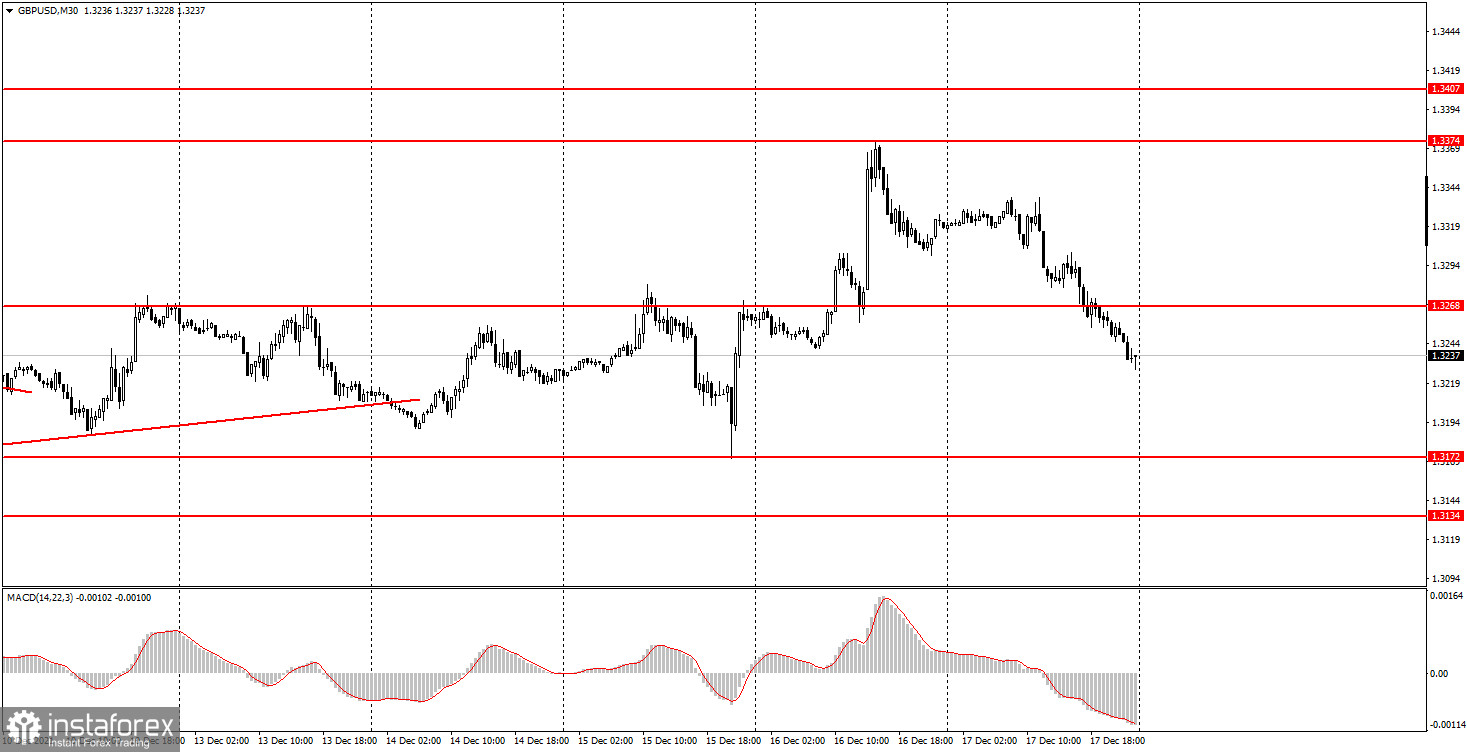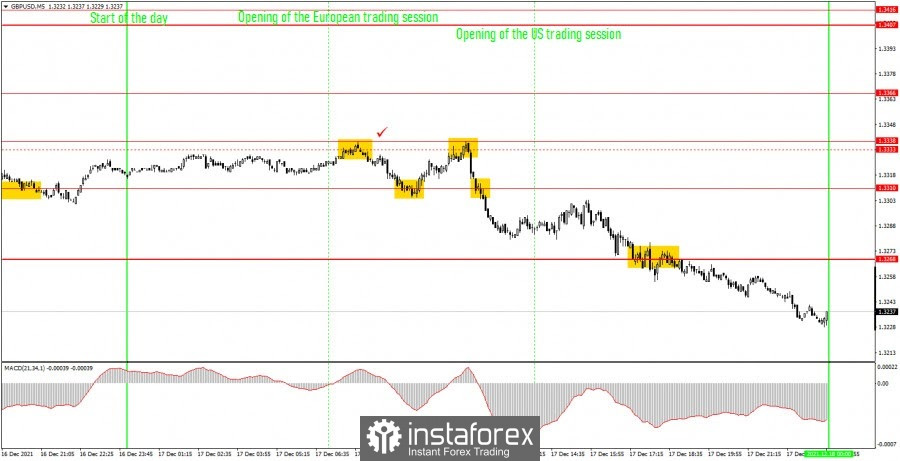Analysis of previous deals:
30M chart of the GBP/USD pair

The GBP/USD pair was also trading quite actively on Friday and with a downward bias. Flat, as for the euro, is not observed, but at the same time, the pair is still between the levels of 1.3172 and 1.3268 most of the time, which is perfectly visible if you zoom out on the 30-minute time frame or just rewind a little. At the moment, the pair has returned to this range, so the pound may be under pressure again, but at the same time, it should be remembered that Christmas week begins tomorrow, and New Year's Week will immediately follow. Thus, the activity of the markets may seriously decrease, and with it the volatility of the pair. Therefore, if in recent weeks, before the meetings of the Bank of England and the Federal Reserve, there was movement in the horizontal channel, then in the next two weeks the probability of a continuation of the flat is high. On Friday, a report on retail sales was published in the UK and this data turned out to be stronger than forecasts, but, as we can see, this did not save the British currency.
5M chart of the GBP/USD pair

On the 5-minute timeframe, the movement of the pound/dollar pair on Friday was very good in terms of trading signals. The first sell signal turned out to be profitable. The price bounced from the level of 1.3333 and dropped to the level of 1.3310, bringing a profit on short positions of ten points. It was also necessary to open long positions on the rebound from the level of 1.3310, and the price returned to the level of 1.3333 and rebounded from it again, where it was necessary to close longs in profit for about five more points. The signal of a rebound from the level of 1.3333 should not have been worked out, since at the time of its formation, the price had already dropped to the level of 1.3310, from which it had previously bounced already. But after overcoming the level of 1.3310, it was necessary to open new short positions unequivocally. Subsequently, the price went down about 60 points, breaking another level on the way – 1.3268. Novice traders could close this deal on any Take Profit or manually in the late afternoon. Thus, a profit of about 55-65 points was obtained for the pound/dollar pair, which covered the loss for the euro/dollar pair. An analysis of the euro/dollar situation can be found here.
How to trade on Monday:
At this time, on the 30-minute timeframe, the pair has fallen below the level of 1.3268, so the upward trend has been canceled before it has even formed. Now the pound/dollar pair has returned to the horizontal channel and can trade in it even until the New Year. The important levels on the 5-minute timeframe are 1.3170, 1.3192, 1.3268, 1.3310. We recommend trading them on Monday. From them, the price can bounce or overcome. As before, we set Take Profit at a distance of 40-50 points. On the 5M TF, you can use all the nearest levels as targets, but then you need to take profit, taking into account the strength of the movement. When passing 20 points in the right direction, we recommend setting the Stop Loss to breakeven. Not a single important report will be published in the UK and the US on December 20. Thus, the pair may start a weak movement tomorrow, since the macroeconomic and fundamental backgrounds will be almost completely absent throughout the next week.
Basic rules of the trading system:
1) The signal strength is calculated by the time it took to form the signal (bounce or overcome the level). The less time it took, the stronger the signal.
2) If two or more deals were opened near a certain level based on false signals (which did not trigger Take Profit or the nearest target level), then all subsequent signals from this level should be ignored.
3) In a flat, any pair can form a lot of false signals or not form them at all. But in any case, at the first signs of a flat, it is better to stop trading.
4) Trade deals are opened in the time period between the beginning of the European session and until the middle of the US one, when all deals must be closed manually.
5) On the 30-minute TF, using signals from the MACD indicator, you can trade only if there is good volatility and a trend, which is confirmed by a trend line or a trend channel.
6) If two levels are located too close to each other (from 5 to 15 points), then they should be considered as an area of support or resistance.
On the chart:
Support and Resistance Levels are the Levels that serve as targets when buying or selling the pair. You can place Take Profit near these levels.
Red lines are the channels or trend lines that display the current trend and show in which direction it is better to trade now.
The MACD indicator consists of a histogram and a signal line. When they cross, this is a signal to enter the market. It is recommended to use this indicator in combination with trend lines (channels and trend lines).
Important speeches and reports (always contained in the news calendar) can greatly influence the movement of a currency pair. Therefore, during their exit, it is recommended to trade as carefully as possible or exit the market in order to avoid a sharp price reversal against the previous movement.
Beginners on Forex should remember that not every single trade has to be profitable. The development of a clear strategy and money management are the key to success in trading over a long period of time.
 English
English 
 Русский
Русский Bahasa Indonesia
Bahasa Indonesia Bahasa Malay
Bahasa Malay ไทย
ไทย Español
Español Deutsch
Deutsch Български
Български Français
Français Tiếng Việt
Tiếng Việt 中文
中文 বাংলা
বাংলা हिन्दी
हिन्दी Čeština
Čeština Українська
Українська Română
Română

